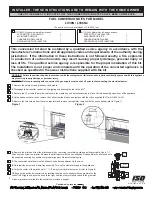
6
The air inlet must have a minimum cross-section of 120cm² (corresponding to a diameter of
125mm). This air must be able to flow freely between the outside and the entrance of the
appliance.
In the following cases:
- Construction with proper tightness (new construction),
- Presence of mechanical ventilation (type C or D),
- Presence of an exhaust hood,
a specific air inlet must be provided, or even preferably an external air intake connection
(previous case)
1.2.
Convection air.
The convection air is the air drawn from the room and heated by the stove, through contact
with the outside of the heating element.
Convection air inlet
Through the filter at the bottom of the door. To ensure sufficient airflow, the filter must be
cleaned regularly.
Hot air outlet
- In front through the gap above the door;
- Through the hot air ducts if installed.
Hot air ducts
The presence of hot air ducts is not essential, but it allows better distributing the heat to an
adjacent room.
They must be connected to the warm air outlets using the flue collars included, and transfer
the hot air outside the cladding. Hot air can reach over 200°C. Use suitable materials (e.g.
aluminium, galvanised steel, stainless steel). Insulate combustible materials on the ceiling
and on the walls around the hot air outlets.
Take care to limit the pressure drop of these warm air pipes by limiting the number of
elbows and respecting the passage sections.
The hot air outlets must always be located above the level of the stove. The more difference
in height between the stove and the outlet, the greater the flow rate.
In case of hot air outlets feeding into another room, provide passages for ductwork and air
return. As illustrated beside, the convection air circuit cannot be broken under any
circumstances.
The supply of these outputs is limited to a maximum of 1 kW per output.







































